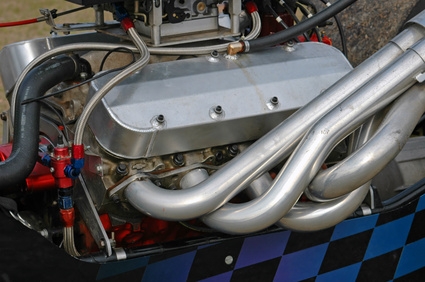
Headers are aftermarket replacements for stock exhaust manifolds. Designers construct headers like separate exhaust pipes for each cylinder. Stock exhaust manifolds are designed to be low-cost rather than high performance, and to use as little metal as possible. The torque specifications for a header are important. The bolts which bind the header to the cylinder head must be correctly torqued or there will be gasket problems and gas leaks, or torn bolts.
Stock manifolds use the least amount of cast iron possible, so car manufacturers can make them cheaply. The exhaust gas from each cylinder travels to the center of the bank of cylinders quickly and gets routed to the exhaust pipe through a central small pipe. The tunnels or "runs" inside the exhaust manifold are small and make unnecessary turns. They gather the exhaust from each cylinder in one pipe at the earliest possible moment. After-market headers use huge steel tubes which lead away from each cylinder for several feet, and don't come together until just before they attach to the exhaust pipe or catalytic converter.
Exhaust gases come in stuttering spurts, not smooth flows, and create pulses that travel through tunnels of the exhaust manifold or header. If the separate cylinders gather together too quickly, the pulses can collide and stop. The pulses of exhaust gases coming from behind must push the ones ahead out of the pipe. Stock exhaust manifolds allow these collisions, which interfere with the removal of the exhaust gases through a situation called "back pressure;" exhaust gas that's become lodged inside the exhaust manifold. Headers, with their long wide tubes, allow the exhaust gases to flow freely away from the engine without interferrng with each other.
Torque is a measure of twisting force. A homeowner twisting a sprinkler onto a garden hose is using the force which torque measures. A mechanic uses a tool called a torque wrench that has a means of showing the mechanic how much twisting force he's applying.
The header doesn't attach directly to the cylinder head. The joining is sealed with a gasket made of soft metal, or a composite material designed to fill the gap between the header and the cylinder head completely, so there are no leaks. The bolts which hold the header and cylinder head together must be tightened enough to keep both parts pressed against the gasket, but not so tightly that the bolt stretches or is damaged.
Each manufacturer will include specifications for tightening the bolts which hold the headers to the cylinder heads. Since headers are after-market items, there is no standardization. Also, each manufacturer will have instructions for the order in which to tighten the bolts, and directions for the preparation of the bolts and gaskets used in each header kit.